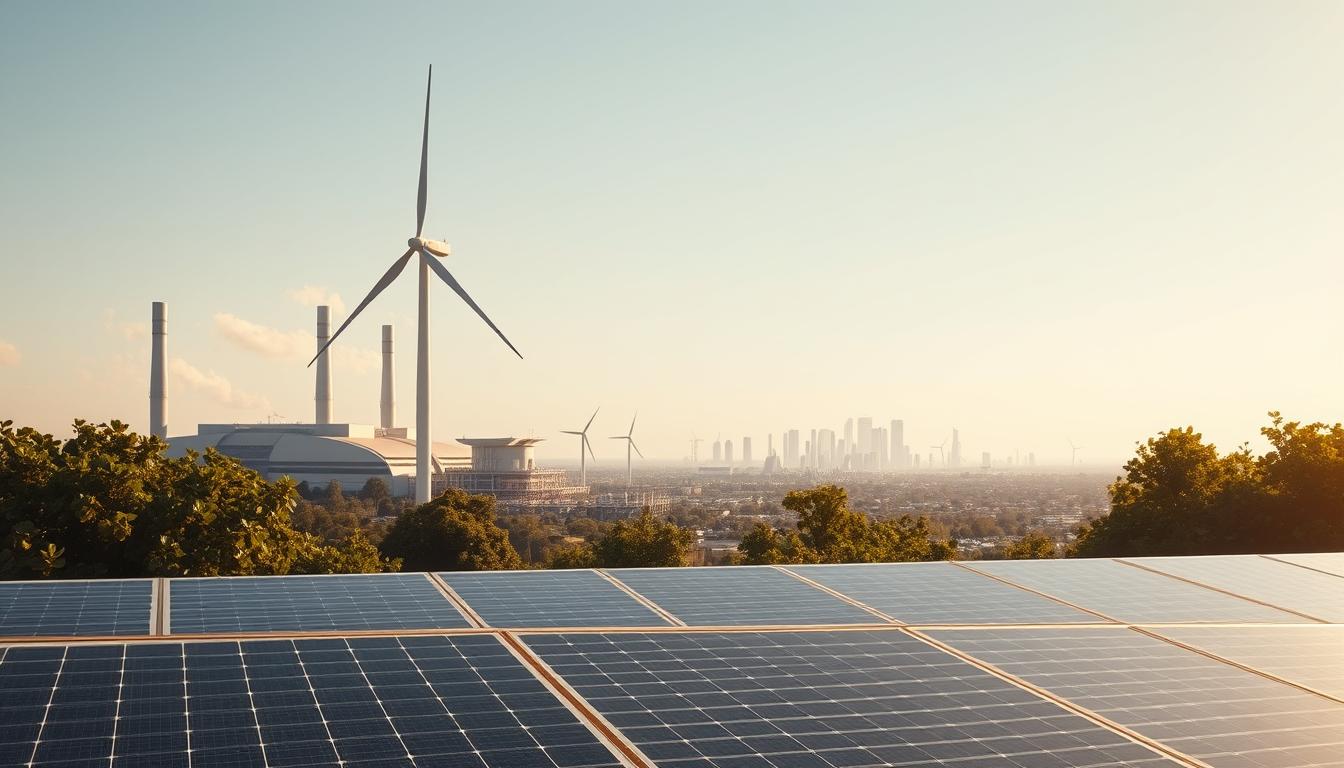
2 Key Technologies Combating Climate Change Today
Did you know switching to renewable energy could cut global greenhouse gas emissions by up to 70%? This shows how big a role climate change mitigation technologies play. With the climate crisis getting worse, tech solutions are key to saving our planet. We’ll look at two important systems: renewable energy and carbon capture. These innovations can help us fight climate change effectively.
Key Takeaways
- Renewable energy sources can significantly reduce greenhouse gas emissions.
- Carbon capture technology plays a crucial role in climate action.
- Innovative advancements are making renewable energy more efficient.
- Community engagement is essential for adopting climate technologies.
- Policies are shaping the development and implementation of climate solutions.
- The transition to green technologies can stimulate economic growth and job creation.
Introduction to Climate Change Technologies
Climate change is a big problem that needs our immediate attention. It causes extreme weather, rising sea levels, and changes in ecosystems. Governments, businesses, and people are now seeing the value of using technology to fight climate change and cut down on greenhouse gases.
Technologies aimed at reducing climate change are key to a sustainable future. They include various strategies and tools to lessen climate change’s impact and encourage environmental care. As research and development keep going, these innovations keep getting better, offering new chances for sustainability.
To make these solutions work, we need to work together at all levels. Investing in climate change technologies helps solve environmental issues and also boosts the economy and creates jobs. By using new technologies, we can build a strong and green world for our children and grandchildren.

Understanding Renewable Energy
Renewable energy comes from natural resources that keep coming back. It’s key in fighting climate change because it cuts down on harmful emissions. By using sustainable tech, we can tap into these resources to lessen climate change’s effects.
What is Renewable Energy?
Renewable energy uses resources that never run out. This includes solar, wind, hydro, geothermal, and biomass. It’s good for the planet and helps us use cleaner energy. Thanks to new tech, using renewable energy is easier and more efficient.
Types of Renewable Energy Sources
- Solar Energy: Solar panels turn sunlight into electricity.
- Wind Energy: Wind turbines turn wind into power.
- Hydroelectric Energy: Water from dams makes electricity.
- Geothermal Energy: Heat from the Earth makes electricity and heat.
- Biomass: Plant and animal waste is turned into energy.
The Role of Renewable Energy in Mitigating Climate Change
Renewable energy is vital in fighting climate change. It cuts down on emissions by using cleaner energy. This not only helps the planet but also boosts the economy and makes us energy-independent.
Countries that go for renewable energy help make our planet greener. This ensures a better future for all of us.

Solar Power: A Game Changer
Solar power technology is a big step forward in energy production. It helps fight climate change by turning sunlight into electricity. This section looks at how solar energy works, its benefits, and cool projects using it.
How Solar Energy Works
Solar energy uses sunlight to make electricity. Photovoltaic cells catch sunlight and turn it into electricity. This energy is good for homes, businesses, and factories, showing solar’s wide use.
Advantages of Solar Technology
- Energy Independence: It cuts down on fossil fuel use, offering a green energy option.
- Cost Reduction: Solar tech can save money on electricity bills as costs go down.
- Environmental Benefits: Solar power cuts down on pollution and greenhouse gases, making the planet healthier.
- Job Creation: Solar projects create jobs, boosting the economy.
Innovative Solar Projects Around the World
There are many cool solar projects out there. Here are some examples:
| Project Name | Location | Description | Output (MW) |
|---|---|---|---|
| Mojave Solar Park | California, USA | One of the largest solar thermal projects, using mirrors to concentrate sunlight. | 392 |
| Gemini Solar Project | Nevada, USA | A massive utility-scale solar project expected to supply energy to hundreds of thousands. | 690 |
| Bhadla Solar Park | Rajasthan, India | The largest solar park worldwide, showing how solar power can be used effectively. | 2245 |
Projects like these show solar energy’s key role in fighting climate change. By supporting solar projects, we can build a greener future. Solar power is crucial for solving the climate crisis.
Wind Energy Advancements
Wind energy technology has grown a lot in recent years. It’s a key part in fighting climate change. Modern wind turbines turn wind into electricity very well. Knowing how they work shows their importance in clean energy today.
Mechanics of Wind Energy Generation
Wind turbines use blades to catch the wind, making them turn. This turning energy makes electricity. New designs and materials have made them better. These changes help them work more efficiently and last longer.
Benefits of Using Wind Energy
Wind energy does more than just power homes. It cuts down on fossil fuel use, improving air quality. It also creates jobs in the green sector, boosting local economies. Being renewable, it helps meet energy needs while reducing carbon emissions.
Future Trends in Wind Technology
Future wind tech looks to bigger offshore farms. These get stronger winds, making more energy. New floating turbines can go deeper, opening up more areas. This progress is key in the fight against climate change.
what two types of technology can mitigate climate change
Finding effective ways to fight climate change is key. Two important technologies are leading the way: renewable energy and carbon capture. Renewable energy uses natural sources like sunlight and wind to create clean power. This helps cut down on fossil fuel use and lowers emissions.
Carbon capture is another crucial tool. It catches carbon dioxide from factories and power plants before it can harm the atmosphere. By combining renewable energy with carbon capture, we can meet climate targets and make our planet more resilient.
Carbon Capture and Storage (CCS) Explained
Carbon capture and storage (CCS) is key in fighting climate change. It captures carbon dioxide from big sources like power plants before it gets into the air. This tech helps cut down on harmful emissions and supports cleaner energy.
How Does Carbon Capture Work?
The carbon capture process has three main parts: capturing, moving, and storing CO2. The CO2 is packed tight and sent through pipes to places deep underground. This keeps the carbon out of the air, helping to lower greenhouse gases. CCS turns big polluters into a tool for change.
Importance of CCS in Climate Action
CCS is vital for fighting climate change. It helps countries meet their climate goals by cutting emissions. For hard-to-clean sectors like cement and steel, CCS is a key solution. It helps move us towards a greener economy.
Global Initiatives on Carbon Capture
Many global efforts show CCS’s power. The Petra Nova project in Texas is a big success story. Other projects around the world are working to use CCS on a big scale. Supporting these efforts helps countries fight climate change and move towards a better future.
Innovative Carbon Utilization Technologies
The field of carbon utilization technology is growing fast. It offers solutions for climate change and new ways to use carbon dioxide. These technologies turn captured CO2 into valuable products, helping the environment and the economy.
Turning CO2 into Useful Products
Innovative carbon technologies can change CO2 emissions into many useful items. These include:
- Plastics
- Fuels
- Concrete
This change helps fight climate change and opens up new markets and sustainable practices.
Significant Projects Utilizing Carbon Utilization
Many companies are leading the way in carbon utilization projects. Some notable ones are:
- Carbon Clean Solutions: Works on capturing CO2 for industrial use.
- Global CCS Institute: Pushes for more carbon capture and utilization technologies.
- Bioenergy with Carbon Capture and Storage (BECCS): Uses biomass energy and carbon capture to cut emissions.
These projects highlight the role of carbon utilization technology in fighting climate change.
Sustainable Energy Storage Solutions
Energy storage technology is crucial for fighting climate change. It helps store extra energy from sources like wind and solar. This stored energy is used when we need it most.
Why Energy Storage is Essential
Energy storage is vital for using renewable energy sources. Wind and solar power are not always available. This makes it hard to keep the energy supply steady.
Energy storage fixes this problem. It lets us use stored energy when we need it. This cuts down on our use of fossil fuels and helps fight climate change.
Current Technologies in Energy Storage
Many new technologies are changing how we store energy:
- Batteries: Lithium-ion and other batteries are used at home and in businesses. They give quick and reliable power.
- Pumped Hydro Storage: This old method uses water to make power when we need it most. It flows water through turbines.
- Compressed Air Energy Storage: This tech compresses air in underground places. The stored energy is used to make electricity later.
- Flywheel Energy Storage: It stores energy as kinetic energy. This allows for fast power release and high efficiency.
Using these technologies can make our energy supply more stable. It’s a big step towards a greener energy future.
Impact of Electric Vehicles on Climate Change
Electric vehicles (EVs) are key in the shift to cleaner transport, helping fight climate change. Advances in battery tech and charging systems are changing cars. This part looks at EV tech and how it helps our planet.
EV Technology Overview
EVs use special batteries to turn electrical energy into movement. These batteries, like lithium-ion, get better, making cars go farther and charge faster. Also, more charging spots are popping up, making it easier to power up.
Companies like Tesla are leading the charge with lots of charging stations and new tech.
Benefits of Electric Vehicles
Switching to EVs is great for the environment. They don’t have tailpipes, so they don’t pollute the air. This is good for our health.
Using EVs is part of the fight against climate change, especially if they run on clean energy. Governments offer tax breaks and rebates to encourage people to buy EVs. This not only helps the planet but also creates jobs in the green sector.
| Benefit | Description |
|---|---|
| Reduced Emissions | Electric vehicles produce zero tailpipe emissions, lowering overall greenhouse gas levels. |
| Energy Efficiency | EVs convert over 77% of electrical energy from the grid to power at the wheels, compared to only 12%-30% for conventional gasoline vehicles. |
| Renewable Energy Integration | EVs can be charged using renewable energy, contributing to a decrease in reliance on fossil fuels. |
| Economic Incentives | Government incentives help lower the cost of purchasing EVs, making them more accessible to consumers. |
The Role of Smart Grids in Energy Management
Smart grid technology is a big step forward in managing energy. It combines digital tech with old-school electricity systems. These networks make energy use better and tackle climate change challenges. They help use energy wisely and add more green energy sources, aiding in long-term climate change solutions.
What Are Smart Grids?
Smart grids are new electrical systems that use digital tech and automation. They use real-time data to manage energy better. This makes energy use more efficient and cuts down on waste, fitting with climate change tech goals.
Benefits of Smart Grid Technology
Smart grid tech brings many good things, including:
- Improved Efficiency: They make energy flow better and cut down on losses, saving money for users.
- Enhanced Reliability: They can spot and fix outages fast, getting power back on quicker.
- Integration of Renewables: They make it easy to add green energy sources, helping move to cleaner energy.
- Demand Response: They help people use less energy when it’s more expensive, balancing demand.
The future of energy depends on smart grid tech. It’s key in fighting climate change. With these systems, communities can build a stronger, greener energy future.
Emerging Technologies in Climate Change Mitigation
New climate technologies are leading the way in fighting environmental challenges. They promise big steps forward in our battle against climate change. Researchers and companies are looking into new ways to change our energy systems.
Green hydrogen production and advanced nuclear energy are among the most exciting options. They could start a new era in sustainable practices.
Highlighting Cutting-edge Solutions
Green hydrogen production uses renewable energy to make hydrogen fuel. This method has zero emissions, making it key for cleaner energy. Advanced nuclear energy, like small modular reactors, also offers safe, efficient, and low-carbon energy.
These innovations are big steps toward energy security and fighting climate change.
Future Outlook for Emerging Technologies
The future of these climate technologies looks bright. More investment and research will help them grow. Their use could change how we produce and use energy.
With support from all sectors, these technologies could fight climate change and boost the economy. They could also create jobs in many industries.
Community Engagement and Technological Adoption
Community engagement is key to using climate change technologies well. When people get involved, they learn and accept new ideas. Local efforts help make sustainable living more common, leading to wider use of climate-fighting tech.
Importance of Public Buy-In for Technology Solutions
Getting the public on board is vital for climate solutions to work. When people are informed and active, they support green practices more. This support makes technology for fighting climate change more effective.
Successful Community Initiatives
Many communities have made a big difference by using technology to fight climate change. Programs that teach and involve people work best. For example, community solar projects let people invest in clean energy and learn about solar power.
Local food projects also help by reducing carbon emissions through gardens. These efforts show how community actions can make a big impact.
Policy and Legislation Supporting Climate Technology
Effective policies and laws are key to moving forward with climate change solutions. They help make renewable energy and carbon capture easier to use. They also push industries to be more sustainable. With the right climate policies, governments can boost innovation and make green tech affordable.
Understanding Current Climate Policies
Climate policies differ around the world, focusing on cutting emissions and using more renewable energy. These policies lay the groundwork for new, green practices. Important parts include:
- Incentives for renewable energy projects, like solar and wind.
- Money for research into new climate solutions.
- Rules that limit carbon emissions in industries.
Future Legislative Changes to Expect
As we learn more about climate change, laws will likely get stronger. We can expect:
- More money for startups working on climate tech.
- Longer tax breaks for companies using green tech.
- Tighter global agreements on greenhouse gases.
These updates aim to speed up the shift to sustainable ways. It’s important to keep up with these changes. This way, we can better fight climate change with new technologies.
The Economic Impact of Climate Change Technologies
Using climate change technologies has big economic effects. It’s important to look at the costs and benefits of these new ways. As we invest in these technologies, we help the economy grow and solve environmental problems.
Cost-Benefit Analysis of Technologies
Looking closely at climate tech shows a good trend. Companies and governments are now weighing the financial and environmental costs. They see the long-term benefits of using less energy and cutting carbon emissions.
Job Creation in the Green Economy
Investing in climate tech creates lots of jobs. The green economy is growing, offering jobs in renewable energy, saving energy, and fixing the environment. Studies show that for every million dollars spent on green tech, seven to ten jobs are made in local areas.
| Investment Area | Jobs Created per $1 Million | Typical Industries |
|---|---|---|
| Renewable Energy | 8-10 | Solar, Wind, Hydropower |
| Energy Efficiency | 9 | Insulation, HVAC, Smart Technologies |
| Sustainable Agriculture | 7-9 | Organic Farming, Permaculture |
| Environmental Restoration | 7 | Reforestation, Wetlands Restoration |
These findings show that using green tech helps solve climate issues and creates jobs. This helps communities all over the country.
Challenges Facing Climate Change Technology Adoption
Introducing new climate solutions faces many challenges. It’s important to know these obstacles to improve technology adoption. Issues like money problems and public doubt can slow down progress.
Common Barriers to Implementation
Several major hurdles block the way for climate tech adoption. These include:
- Financial Constraints: High costs can stop companies and governments from buying new tech.
- Regulatory Challenges: Old laws might not help new tech grow fast enough.
- Public Awareness: Not enough people know about or trust climate tech.
Strategies for Overcoming Challenges
To beat these obstacles, we can try different approaches:
- Funding and Incentives: Grants and subsidies can help cover costs and encourage use.
- Education and Outreach: Teaching more about climate tech can win over public support.
- Collaborative Partnerships: Working together can build a better environment for these solutions.
The Importance of Ongoing Research and Development
Research in climate change technology is key to our planet’s future. We need to keep working on new solutions to fight climate change. This work improves what we already have and brings new ideas to the table.
Current Research Initiatives
Many groups around the world are working hard to improve climate change technology. They are doing things like:
- Creating systems that turn CO2 into useful materials.
- Working on better renewable energy systems to save more and store more.
- Looking into farming methods that can handle climate change and still grow food.
The Future of Research in Climate Technologies
The future looks bright for climate change technology research. We can expect to see:
- Artificial intelligence helping us use energy better and predict climate changes.
- More research happening in local communities to find solutions for their specific problems.
- Teams from schools, businesses, and governments working together to make new technologies real.
As climate technology keeps growing, focusing on research and development will be crucial. It will help us reach our goals for a sustainable future.
| Initiative Type | Focus Area | Expected Outcome |
|---|---|---|
| Carbon Capture | CO2 Utilization | Reusable Materials |
| Renewable Energy | Efficiency Improvements | Sustainable Energy Supply |
| Agricultural Practices | Climate Resilience | Sustainable Food Production |
Conclusion
In our fight against climate change, two key technologies are crucial: renewable energy and carbon capture. These technologies are vital in addressing our environmental challenges. Renewable energy, like solar and wind power, is key in moving away from fossil fuels. This helps cut down on harmful greenhouse gas emissions.
Carbon capture technologies also play a big role. They help remove CO2 from the air. This is essential in reducing our carbon footprint. The progress in these areas is not just new ideas; they are essential for a sustainable future.
It’s important to understand the role we play in supporting these technologies. By doing so, we join a global effort to fight climate change and protect our planet. With awareness and action, we can make a difference. We can work towards a cleaner, greener world.
FAQ
What are the two key technologies that can mitigate climate change?
To fight climate change, we need renewable energy and carbon capture and storage (CCS). These technologies cut down on greenhouse gas emissions. They help us move towards a more sustainable future.
How does renewable energy contribute to climate change mitigation?
Renewable energy, like solar and wind, reduces our use of fossil fuels. This lowers greenhouse gas emissions. It makes our energy cleaner and more secure.
What is carbon capture and storage (CCS)? Is it effective?
CCS captures CO2 from sources and stores it underground. It’s a key technology because it keeps CO2 out of the air. This helps lower greenhouse gas levels.
What are some innovative carbon utilization technologies?
New technologies turn CO2 into products like plastics and fuels. They also make concrete. These innovations help us use CO2 in a useful way.
How important is energy storage in renewable energy systems?
Energy storage is crucial for renewable energy. It helps manage the ups and downs of wind and solar power. Technologies like batteries keep the energy flowing smoothly.
How do electric vehicles (EVs) help fight climate change?
EVs cut down on emissions by using electricity instead of gas. Better batteries and more charging spots are key. They help reduce greenhouse gases.
What role do smart grids play in climate technology?
Smart grids use digital tech to manage energy better. They make electricity use more efficient and reliable. They also help use more renewable energy.
What are some barriers to adopting climate change technologies?
Money, doubt, and rules can hold back these technologies. We need to work together to overcome these hurdles. This will help us innovate and use these solutions.
Why is ongoing research and development crucial for climate change technologies?
Ongoing research is key to improving climate change tech. It helps us find better ways to solve these problems. This leads to more sustainable practices.







